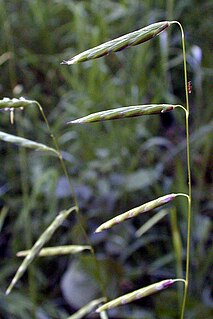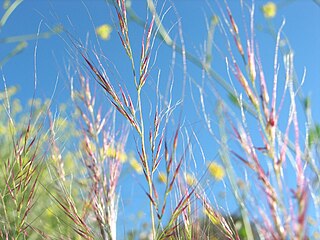
Alopecurus pratensis, known as the meadow foxtail or the field meadow foxtail, is a perennial grass belonging to the grass family (Poaceae). It is native to Europe and Asia.

Danthonia californica is a species of grass known by the common name California oatgrass. This plant is native to two separate regions of the Americas, western North America from California to Saskatchewan, and Chile.

Danthonia intermedia is a species of grass known by the common names timber oatgrass, intermediate oatgrass, and mountain wild-oat grass. This clumping erect perennial grass is native to North America, where it is widespread across most of Canada and along the western United States into California. It is a plant of the plains as well as forested, mountainous, alpine environments.

Elymus glaucus is a species of wild rye known by the common name blue wild rye. This grass is native to North America from Alaska to New York to northern Mexico. It is a common and widespread species of wild rye.

Aira praecox is a species of grass known by several common names, including early hair-grass, yellow hairgrass and spike hairgrass. It is native to Europe. It also grows in North America as an introduced species, where it can be found on the east and west coasts in sandy or rocky areas, such as beaches and roadsides. This is a tuft-forming annual grass growing up to about 25 centimeters in maximum height. The thin, narrow leaves are located at the base of the stem. It bears very small inflorescences of purple-tinted green bisexual spikelets.

Aristida adscensionis is a species of grass known by the common name sixweeks threeawn. It is native to the Americas but it is distributed nearly worldwide. It grows easily in disturbed and waste areas and has potential to become a weed.

Bothriochloa barbinodis is a species of grass known by the common name cane bluestem. It is native to the Americas, including most of South and Central America, Mexico, and the southernmost continental United States from California to Florida.

Cynosurus echinatus is a species of grass known by the common names bristly dogstail grass, rough dog's-tail and hedgehog dogtail. It is native to southern Europe, and it is known in the Americas and Australia as an introduced species and sometimes a noxious weed. An herbicide-resistant strain can be found growing as a weed in canola and wheat fields in Chile. This is an annual grass growing 10 to 50 centimeters tall. The inflorescence is a rounded or oval cluster or series of clusters of spikelets. The fertile spikelet has an awn up to a centimeter long. The awns clumped closely together into a tuft gives the inflorescence its bristly, hairy appearance.

Danthonia unispicata is a species of grass known by the common name onespike oatgrass, or onespike danthonia.

Polypogon monspeliensis, commonly known as annual beard-grass or annual rabbitsfoot grass, is a species of grass. It is native to southern Europe, but it can be found today throughout the world as an introduced species and sometimes a noxious weed. It is an annual grass growing to heights between 5 centimeters and one meter. The soft, fluffy inflorescence is a dense, greenish, plumelike panicle, sometimes divided into lobes. The spikelets have long, thin, whitish awns, which give the inflorescence its texture.

Melica aristata is a species of grass known by the common names awned melic and bearded melicgrass.
Melica geyeri is a species of grass known by the common name Geyer's oniongrass.
Muhlenbergia andina, known by the common name foxtail muhly, is a species of grass. It is native to western North America from British Columbia to California to Texas. It grows in moist habitat such as meadows, marshes, and riparian riverbanks.

Muhlenbergia appressa, the common name Devils Canyon muhly, is a species of grass. It is native to the desert region where California and Arizona border Baja California. Muhlenbergia appressa has also been collected on San Clemente Island, one of the Channel Islands of California, in the chaparral and woodlands habitat..

Muhlenbergia microsperma is a species of grass known by the common name littleseed muhly. It is native to the Americas from the Southwestern United States and California through Central America into Peru and Venezuela.

Pleuropogon hooverianus is a rare species of grass known by the common name North Coast semaphoregrass. It is endemic to northern California, where it is known from Mendocino, Marin, and Sonoma Counties. It grows in moist marshy areas and shady redwood forests. It is an erect perennial grass growing to a maximum height between one and 1.6 meters. The inflorescence bears widely spaced narrowly cylindrical spikelets which hang sideways off the stem, resembling semaphore signals. Each spikelet may be up to 4.5 centimeters long and may contain up to 16 flowers.

Poa howellii is a species of grass known by the common name Howell's bluegrass.

Poa leptocoma is a species of grass known by the common names marsh bluegrass and western bog bluegrass. It is native to western North America from Alaska to New Mexico, where it grows in subalpine and alpine climates and the Arctic. It is also known from the Kamchatka Peninsula.

Ventenata dubia is a species of grass known by the common names North Africa grass and wiregrass. It is native to southern Europe, North Africa and the Middle East. It is becoming well known in North America, where it is an introduced species and a noxious weed of cultivated and disturbed habitat. It is problematic in the Pacific Northwest, where it was first identified in Washington in 1952 and Idaho in 1957. It was found in Utah in 1996. It probably spreads when it gets mixed in with grass seed and is transported and inadvertently planted.

Vulpia microstachys is a species of grass known by the common names small fescue and small sixweeks grass. It is native to western North America from British Columbia to Colorado and New Mexico to Baja California, where it grows in many types of open habitat, including grasslands. It is dominant on some grasslands of California, and it was probably an abundant native grass before the habitat was altered by invasive non-native grasses. It occurs on serpentine soils with associates such as serpentine reedgrass. It is also known from parts of South America. It is an annual grass producing one stem or a clump of several stems growing up to 75 centimeters tall. The inflorescence has several open branches bearing clusters of purple-tinged spikelets. The spikelet has 1 to 6 flowers. The grass is usually cleistogamous, its flowers fertilizing themselves.





















